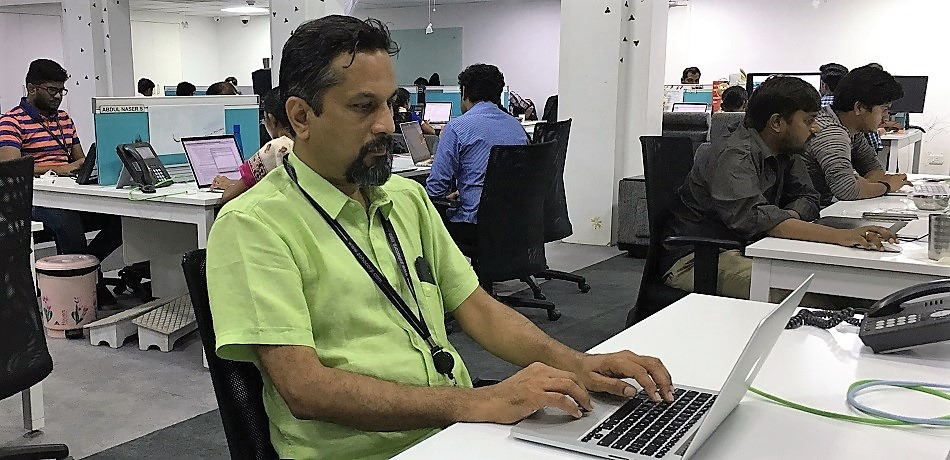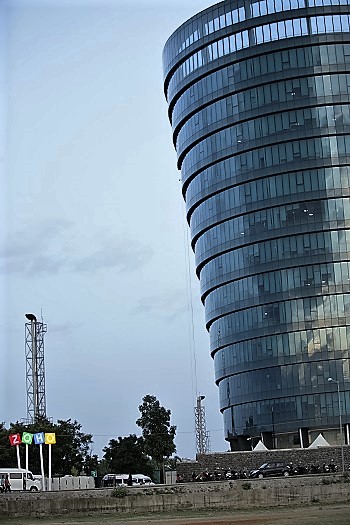
Sridhar Vembu, founder and CEO of Zoho, in his Guduvanchery office. Photo credit: Aravind Natarajan
The banyan is India’s national tree. Its branches drop aerial roots, and older trees can look like they have several stems as they spread out over a large area.
Zoho, whose SaaS suite serves 20 million users around the world, has a large banyan tree in its campus just outside Chennai in southern India. Sometimes outdoor meetings are held in its leafy shade, as sages would do in ancient India.
At one such recent meeting, an oft-repeated question came up: why doesn’t India produce a Facebook which got a billion users in just 10 years?
VCs that aim for exits in five to eight or ten years don’t create durable companies.
“Facebook is like one of the trunks of this banyan tree,” Sridhar Vembu, founder and CEO of Zoho, told the gathering. “The banyan tree has to exist for the trunks to grow.”
His banyan tree metaphor was for the broad foundation of Silicon Valley which had been built up over decades. Facebook, Google, and others are like the trunks of the banyan tree.
“Even though Facebook is a new company, the talent it drew was already established,” he explains to me. “Sun gave rise to Google in a way, because a lot of Google engineers came from Sun. So it takes time to build a foundation and companies on top of that.”
The Zoho mafia
We’re on one of the higher floors of a massive, bucket-shaped building rising like a colossus in a rural, agricultural area outside the capital of Tamil Nadu. Zoho, which employs over 4,000 people, bought the building from L&T which had originally designed it for use by multiple software companies.

The Zoho building in Guduvanchery outside Chennai rises like a colossus over the countryside. Photo credit: Zoho
Sridhar, geekily attired in Bermuda shorts, points to the construction work going on below. He wants the Zoho campus to be a place for “collaboration and contemplation.” Tree-lined streetscapes and buildings no taller than three or four storeys will be designed for that purpose.
His banyan tree metaphor comes to mind in a different context. It strikes me that we’re in the trunk of what has grown into one of the world’s leading SaaS hubs.
Zoho was the first to spot the opportunity to make cloud-based software products out of Chennai for global customers, back in 2005. Since then, a number of SaaS startups have emerged in Chennai, several of which trace their roots back to Zoho.
On the cloud, you won’t use 50 different products. You need an ecosystem of products that work well together.
The best known of them is Freshdesk, a global leader in customer engagement software, whose founder Girish Mathrubootham rose to the position of VP in Zoho before striking out on his own in 2010. The trend has continued.
Zarget, which built a suite of tools to improve ecommerce conversion, raised US$1.5 million in seed funding from leading VCs Accel Partners and Matrix Partners within two months of its founding. The VCs needed no second-guessing on the startup’s potential because all three founders earned their spurs at Zoho.
Make in India
For the pioneer, who co-founded AdventNet in the late nineties in the US – the original avatar of Zoho Corp – it was a very different landscape. The IIT Madras grad with a PhD in electrical engineering from Princeton University was working as a wireless systems engineer in Qualcomm when the idea of building an Indian software product company first took root in his mind.
Sridhar would go to stores in the US and see things made in China or Korea or Taiwan. Hardly anything from India. “If we want to trade with the world, we have to export something,” he tells me, still driven by what he had felt 20 years earlier. “India’s exports are mainly in the form of labor, which we send to the Middle East, or labor-embedded services via outsourcing. But the ability to make things is lacking.”
Mentally I was prepared for the long haul… It wasn’t a five-year thing. It would take 30 or 40 years.
So even though the turn of the millennium saw an IT services boom from India, he took a different path. “I was aware we needed to make products: software, phones, all of it…”
He is saddened to see that even today a country of this size cannot make the camera, chip, or processor that goes into a smartphone. But at least software products are making a dent.
Zoho’s predecessor AdventNet began with making software to manage printers. There were many companies making printers, but few making software for them. So there was an opportunity. For Sridhar, it has always been about grabbing short-term opportunities to put money on the table, combined with a long-term vision of building a big Indian software product company.
He has misgivings about the VC-funded exit-focused startup model. “VCs that aim for exits in five to eight or ten years don’t create durable companies… I realized that in India it wasn’t possible. The reason it works in Silicon Valley is the foundation of skills which enables a faster, optimal path. Without that foundation, it’s sub-optimal.”
See: Thrillers to tragedies: India’s failed ecommerce pioneer on what ails Flipkart, Snapdeal
Three stages of evolution
Today the SaaS companies coming up in Chennai have the banyan tree. But Sridhar knew Zoho had to grow the slow way. “Mentally I was prepared for the long haul… It wasn’t a five-year thing. It would take 30 or 40 years.”
That commitment led to a steadfast rejection of funding and buyout offers that came his way over the years. Of course, he had to balance that with the agility to keep his company profitable. His ability to visualize tech trends has been a big help in this.
The telecom bubble, which happened around the same time as the dotcom bubble, brought a lot of business his way. It was an optical gold rush with hundreds of small telecom firms sprouting. AdventNet made software to manage the optical lines.
When the seventh company you visit is doing exactly the same thing as the six others, you know there’s a problem.
Sridhar knew it couldn’t last. “When the seventh company you visit is doing exactly the same thing as the six others, you know there’s a problem.” But even he was taken aback by the swiftness and totality of the collapse – almost all those companies have vanished. “It has happened before, and it will happen again,” he says philosophically.
Luckily, he had been frugal with his spending. So now, after the telecom bubble burst, he was sitting on a pile of cash, even though he had no business. The money went into creating the ManageEngine division, which started making software to manage IT networks.
Sridhar also became aware of the need to shift to broader markets. The bubbles had taught him that single-product companies often vanish without a trace. His firm would have to build a suite of products, and the opportunity for that came with a shift to the cloud around 2005. The Zoho division came up to build a series of cloud-based productivity tools for business users. The company later changed its name to Zoho as SaaS products became its mainstay.
See: Here seasoned founders make bulbs flash in the heads of newbies
The future
After three evolutionary stages, Sridhar is open-minded. “I still don’t know what Zoho’s path will be 10 years from now, which is part of the fun – discovering new things to do, new competencies…”
For now, the company is focusing on adding new products to its suite and making them work together as seamlessly as possible. CRM, email, documents, invoices, project management… the Zoho suite aims to serve all the needs of business users.
“On the cloud, you won’t use 50 different products. You need an ecosystem of products that work well together,” explains Sridhar. For example, there should ideally be seamless flows between email and chat apps in the social age.
I still don’t know what Zoho’s path will be 10 years from now, which is part of the fun – discovering new things to do.
He faces formidable competition from the likes of Google and Salesforce, as well as nimble new players, but he’s confident of Zoho’s strengths. Unlike Google, which has been mostly consumer-facing, Zoho has focused on the needs of business users from the outset. And it was early into building a suite of products, which Salesforce is now doing through acquisitions, such as that of word processor Quip for US$750 million three months ago. “Ten years too late,” quips Sridhar with a chuckle.
Sridhar divides his time between the Zoho office in Chennai and his home in California, where he takes care of his autistic 17-year-old son. The challenge of raising a kid with autism puts things into perspective for him. “I don’t get up in the morning worrying about Google killing us.” His personal vision is to create a work environment for people who have skills but not social ones.
As for Zoho, he likes to see it hum by itself, where the emphasis is on building people up. “Different people exhibit different strengths. Then you try to flow them into the natural path they would go on anyway.” And if that path should lead some of them to eventually launch their own companies, that is also in the natural scheme of things – for the banyan tree to grow new trunks and create an ecosystem.
This post How this pioneer built a SaaS hub in Chennai from scratch without VC money appeared first on Tech in Asia.
from Tech in Asia https://www.techinasia.com/pioneer-who-built-saas-hub-from-scratch
via IFTTT
No comments:
Post a Comment